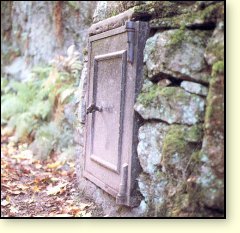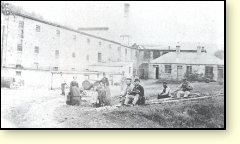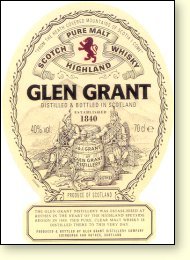
 |
|
Location: Rothes, Morayshire IV33 7BS
Roads: At north end of village on main road
Hours: 9.30am - 4pm, Mon - Sat. Sun.12.30-4.00pm
Groups: Yes, starting times as required. Explanations in French, German, Italian, Spanish and Japanese
Reception centre and shop. Admission charges
Phone: 01542 783318
Fax: 01542 783306
|
Text from The Whisky Trails, Copyright © Gordon Brown 1993:

Distillery workers take a break outside Glen Grant distillery at the end of the 19th century.
|
Glen Grant opened its doors in Rothes in 1840 and was the first distillery in the town; and for the next 40 years it remained the only one. The distillery was also the first industrial premises in the North of Scotland to have electric light. Glen Grant has played a formative role in introducing malt whisky to consumers outside Scotland, notably in Italy which is now the No 1 world market for malts. The Glen Grant brand is seen as the epitome of malt whisky in Italy where the tradition of drinking it young – say, five years old – is firmly established.
As may be expected, the distillery has some interesting traditions, and there are many anecdotes about early proprietors. Today, VIP guests taken for a short walk in the pretty little glen behind the distillery are usually served a surprise glass of whisky from a bottle stored in a recess by the burn; water is added from a jug filled from the burn. This company tradition goes all the way back to Major James Grant, son of the co-founder of the distillery, whose idea it first was.
Brothers John and James Grant built the distillery at the north end of Rothes in 1840. They had been smugglers and they had also worked Dandaleith distillery near Craigellachie in the 1830s. James qualified as a lawyer and practised in Elgin but he was drawn back to the idea of a distilling partnership with his brother. James was Provost (Mayor) of Elgin for a number of years and he did much to promote the railway throughout the county.
James Grant’s son, Major James, built a beautiful mansion nearby as the family home. He also built a second distillery across the road in 1898 called simply Glen Grant No 2 and a famous ‘whisky pipe’ ran across the road carrying spirit to be merged with the flow on the other side. Glen Grant No 2 closed in 1902 and when revived was designated a separate distillery and named Caperdonich. Once when on safari in Africa, Major James met a young Matabele lad who had become isolated from his family. He brought him back to Rothes, made him his personal valet and, with the similarities to the story of Robinson Crusoe in mind, the locals christened him ‘Friday’. He settled down in Rothes and spent the rest of his life in a rent-free flat in the Grant mansion.
The industrial plant just by the distillery on the outskirts of Rothes is unsightly but it should not be regarded too harshly since it represents the combined efforts of otherwise competitor distiller companies to minimise the effects on the area of the effluent they produce. The works transforms the effluent into nourishing cattle feed. The original Glen Grant had floor maltings but, following the inspiration of neighbouring Speyburn, one of the last distilleries to be built in Rothes on a somewhat cramped site, it also installed drum maltings in 1898. The former were closed in 1964 to make way for Caperdonich’s renewal, and the latter closed eight years later.
There are four pairs of stills in position now compared to the original two pairs set up with the distillery in 1840. They are coal-fired and, although the new stills – installed in the mid-1980s – are larger than before, they seem to be continuing to produce the same type of spirit. All of the stills have purifiers fitted, which add finesse to the style of the spirit produced.
In the 1980s reconstruction, the worm-tubs were replaced with condensers. The four old stills recently removed had the last rummagers in the Scotch whisky industry to be driven by a waterwheel.
The Whisky
Text from The Whisky Trails, Copyright © Gordon Brown 1993:

Hidden in the beautifully landscaped grounds of the Glen Grant distillery is the whisky safe where Major Grant stored bottles to share with friends.
|
The core flavour of Glen Grant is light, dryish, slightly spirity and gently nutty with sweet, herby overtones. This, however, is developed in many ways by almost endless combinations of age and type of cask used for ageing. There seems to be no definitive Glen Grant at least in terms of age.
The company markets a ten- year-old version, and age-unspecified versions. The independents offer an apparently unlimited choice of ages up to 25 years and over a dozen vintages going back to the mid-1930s.
Source of water
Caperdonich Well